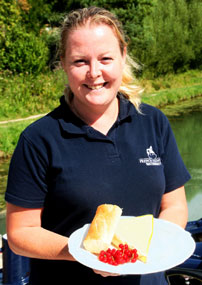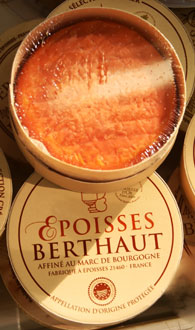|
by Llewellyn Toulmin
Charles de Gaulle once famously said, “How can anyone be expected to govern a country with 325 cheeses?” Luckily for us, France is now even more ungovernable, with over 700 types of cheese to sample and enjoy. As a passenger on an August 2009 cruise on the Burgundy Canal aboard French Country Waterways Horizon II, I picked the brain of FCW’s cheese and wine expert Emma Dumel (www.fcwl.com; 800-222-1236, 1-781-934-2454; PO Box 2195, Duxbury, MA 02331 USA). She said, “To really experience France, you must learn about French cheese. That is why we serve 27 varieties of cheese in a week of cruising.”
Once in France, you should focus mainly on the “artisanal” cheeses rather than the “industriel,” “cooperative” or “fermier” cheeses. The artisanal cheeses are carefully made in small batches, while the industriel and cooperative are factory-scale productions, and the fermier are tiny individual productions that are not readily available. Said Emma, “go to cheese stalls in weekly town markets, cheese shops, and even supermarkets like Carrefour and Super U, which will have large cheese counters and knowledgeable staff.” Emma continued, “At these establishments, don’t hesitate to ask for five or six slivers of different cheeses to taste. The minimum amount to buy is usually 100 or 150 grams” [about 3.5 to 5.2 ounces]. Emma gave out a little secret: “On Horizon II we buy all our cheese at Les Fromages de Sylvain.” [1 Grand Rue, Flogny la Chapelle in Burgundy; tel. 03-86-75-59-74, www.lesfromagesdesylvain.fr; this firm has a stall at weekly markets in Burgundy at the towns of Tonnerre and Chablis on Saturday and Sunday, respectively.] Learn to pick your favorite types of cheese by eye, differentiating the hard from the soft, the dry from the creamy, and the goat (“chevres”) from the ewes (“barbis”) and the cow (“vaches”) or the mixed milk (“lait de mélange”). Emma noted that “the famous AOC label is a guarantee of quality – it stands for ‘Appelation d’Origine Contrôlée’ and is a French certificate used in wine, cheese, bottled water and other products, which ensures that specified methods of production were used in a certain region.” Any violation by manufacturers of the AOC rules carries a fine and a jail term of up to a year, so this label is taken quite seriously.
Sample some of the classic cheeses that are generally available nation-wide, such as Brie, Cantal, Compté, Emmantal, Camenbert, Époisses de Bourgogne, Roquefort and Abondance. Then narrow your quest, based on your preferences. For example, suppose you like the amazingly soft, pungent and milky Époisses de Bourgogne (a favorite of Napoleon, which he paired with Chambertin wine). Then you might proceed next to try the similar but harder-to-find Affidelice, also made in Époisses, Burgundy, but washed 1-3 times per day in Chablis wine instead of in marc de Bourgogne. Prices for classic cheeses in a supermarket can vary from 3 euros (about $4.20) for 150 grams for a Brie, to 10 euros for 150 grams of an aged Compté. Rarer artisanal cheeses vary hugely in price, from a few euros per 150 grams up to 6 euros for a Delice de Bourgogne (double cream cow’s milk) or 15 euros for a pungent Maroilles (cow’s milk cheese from Picardy in northeast France, soft and golden, first made by a monk in 962). You can score some bargains by buying local cheeses. For example, a 250 gram President Petit Camembert made in Normandy and purchased locally in a supermarket there cost only 1.56 euros ($2.18), and a locally made 250 gram Réo Camembert with AOC label cost only 2.90 euros ($4.06). When the magic moment comes to serve your selected cheese, Emma recommended that, “most cheeses should be left at room temperature for at least 30 minutes before serving, to maximize their bouquet. But some cheeses like the light, frothy Brillat-Savarin, can get too runny after just 45 minutes at room temperature. Keep your cheeses refrigerated in the wax paper they are sold in, and don’t use plastic cling wrap.” A great way to save money while touring in France is to picnic with the “Holy Trinity” of food: local cheese, bread and wine. Round this out with a little local pate or sausage, and at today’s restaurant prices you can save 25-30 euros per person per meal. For breakfast, save 15-20 euros per person off the rip-off hotel restaurant prices by eating a nice meal in your room of fromage blanc (similar to yogurt), mixed with raisins, whipped cream and honey. Eating cheese probably dates back to the domestication of sheep and goats, 10,000 years ago. Hopefully mankind will still be visiting France and chasing hundreds of cheese sensations, 10,000 years from now!
* * *
Lew Toulmin is a travel writer living in Silver Spring, Maryland, USA. He has traveled to over 175 countries and sovereign territories, and descends from a French family in Brittany which has been eating cheese since 1584. Close this window |

